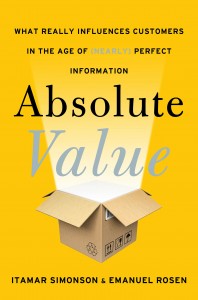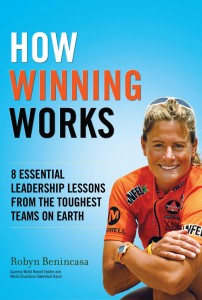 Remember Emanuel Rosen? Author of Anatomy of Buzz and Anatomy of Buzz Revisited? He is out with a new book entitled Absolute Value: What Really Influences Customers in the Age of (Nearly) Perfect Information with co-author Itamar Simonson. To me, the book is a highly thoughtful trip down the changes of the Internet and the personal growth of the author along with it to reach towards different topics and conclusions. I respect this journey immensely as it is a journey all executives should be taking and it is one that I’m on myself.
Remember Emanuel Rosen? Author of Anatomy of Buzz and Anatomy of Buzz Revisited? He is out with a new book entitled Absolute Value: What Really Influences Customers in the Age of (Nearly) Perfect Information with co-author Itamar Simonson. To me, the book is a highly thoughtful trip down the changes of the Internet and the personal growth of the author along with it to reach towards different topics and conclusions. I respect this journey immensely as it is a journey all executives should be taking and it is one that I’m on myself.
The extensive research in the book also serves to validate much of my research and it is nice to find authors demonstrating thought outside the current group think. This book is about much, much more than marketing and should be read by those outside the discipline first and foremost. There is no higher compliment I can give to a book on marketing than that suggestion. We are living in a time when corporate organizational charts are starting to be redefined and so far as a society we are stuck at the starting gate of the race. Those who break free will pull away from their peers. Please share this interview and encourage others to read this great book! Enjoy the conversation.
Q: How was it different to write this book with a co-author?
A: When you write by yourself, you go through long periods where things are in your head. When you work with a co-author, you get immediate feedback on every thought. It’s a very different process and I was lucky to have Itamar Simonson as my co-author. Itamar is one of the world’s leading authorities on consumer decision making. Very knowledgeable and open minded. It’s been certainly a productive collaboration.
Q: This book appears to have taken a long time to write. As someone who has researched a proposal, I can appreciate and respect this. This book is quality, it was not slapped together quickly. Please discuss the reasons for this and the impacts it had on the final product?
A: Indeed, it took us a long time to write this book and we’re happy with the final product. We were exploring a lot of ideas, and we weren’t shy about changing our minds. This usually takes time. Some people work faster (and still write good books), but this is the way it worked in our case. We both felt that even though a lot has been written about the Internet’s impact on marketing, something bigger was happening, and we wanted to get to the bottom of it.
Q: Long before ASUS built laptops, they built motherboards. In custom build computers, people had the choice of choosing ASUS or not for a long, long time. Did you explore the impact of this previous awareness on ASUS laptop sales?
A: Yes, this was a factor that facilitated their market penetration. Because of their experience with motherboards, ASUS had good awareness among power users, so when ASUS started selling laptops under its own brand those in the know, who can easily assess the quality of ASUS, made their verdict and published it in reviews, blogs, discussion boards etc. This, of course doesn’t mean that they endorse every product from the company. Some products from ASUS get high ratings and some don’t.
Q: We see lots of business models changing. Do you think part of the reason they entered the market was to protect ASUS motherboard market share? (For more on this topic, please see my recent article on Steve Jobs.)
A: Yes, their shift to the consumer market was triggered by others’ move into their turf—motherboards. This made it clear to ASUS (and other manufacturers) how vulnerable they were.
Q: Conversations about information overload aren’t new. I liked your example from 1545 where Ann Blair talked about a “confusing and harmful abundance of books’. It is not new, but is it different now?
A: Of course, today we all face unprecedented amounts of information. But while this is true, consumers are actually very good at identifying that slice of information that is most relevant to them. Using new search tools, they can use information selectively and efficiently and benefit from it without being overwhelmed or overloaded. Information abundance as we know it today is a very new phenomenon in the history of the human race, and it will probably take a while before we fully comprehend its implications. The conclusion that it paralyzes decision making seems a bit hurried. While some consumers are indeed overwhelmed, most consumers can handle the information just fine.
Q: For mass markets with large volumes of information, lack of information is clearly not an issue as your research shows. When it is a new paradigm changing service people aren’t looking for yet or a thinly provided product or service, this information becomes imperfect due to the illiquidity. What would you advise providers of elite, low demand niche services to do in this environment to create trust and sales?
A: When a product category doesn’t have enough users, it’s obviously hard to expect many user reviews. For example, you won’t find too many organized review sites for private jets (although you ca still find much more information in this category than in the past). The role of experts and other influencers in such cases is then more significant. Customers in these areas also still rely on the marketer to provide the information which means that the marketer still can have significant influence.
Q: Why were Peter Rojas’ blogs successful for technology and yet some other new verticals in society don’t have sites of this nature? While we are at it, what do you see as the future of blogs?
A: Engadget and the other services that Rojas started were successful because a lot of people are interested in consumer electronics and share their experiences. When there is significant demand and where quality can be assessed, tools are likely to emerge (although this may take time). Marketers should be on the lookout for game-changing technologies that might lead to new types of information sources . The trends we discuss in the book may be vaguely relevant to a company today but increasingly important only a few years later
Q: Not exactly a surprise to people that know me well, my favorite chapter was “When Brands Mean Less”. In fact, one could argue this would have been a great title for the book. Without spoiling the amazing content in the chapter, could you please discuss how this chapter came together?
A: This chapter opens the second part of the book “How Marketing Changes Forever” and it’s been getting a lot of attention since the book came out. What we say in this chapter is that the power of brand as a main cue for quality is diminishing when customers can use reviews from other users and experts to assess the absolute value of products and services. Brands still have some important roles that are not likely to go away, but when it comes to assessing quality, things are changing pretty dramatically.
Q: The book has mostly consumer examples, what are B2B business people to consider here? What is different?
A: The same general principles apply: Whenever customers rely on reviews (from experts & other users) the rules of marketing are changing. The key question the marketer should ask is: To what extent do my customers rely on these new sources of information? In many areas in B2B, this is not yet happening, but this is starting to change in some categories. For example, suppose you’re a B2B software company. A site like http://www.trustradius.com/ which focuses on business software may signal a shift if your customers actually use it. If that’s the case, you need to promote an ongoing flow of authentic content from your users to make sure potential customers find reviews of your software that are relevant and current. In general, customers are likely to prefer objective reviews over things like case studies or white papers because they are perceived as more credible and give potential users a sense of what to expect. For some (especially large) customers things are not significantly different because they have always had the in-house expertise to assess absolute value, but today this type of knowledge is becoming accessible to more companies—even small companies. In addition, sites like LinkedIn or Glassdoor have also changed things for B2B marketers as they help potential customers know what is happening within companies: who work there, who used to work there, etc. Incidentally, the lines between B2B and B2C have been blurred. Routers are reviewed on Engadget and projectors used in business presentations are reviewed on Amazon or PC Magazine.


